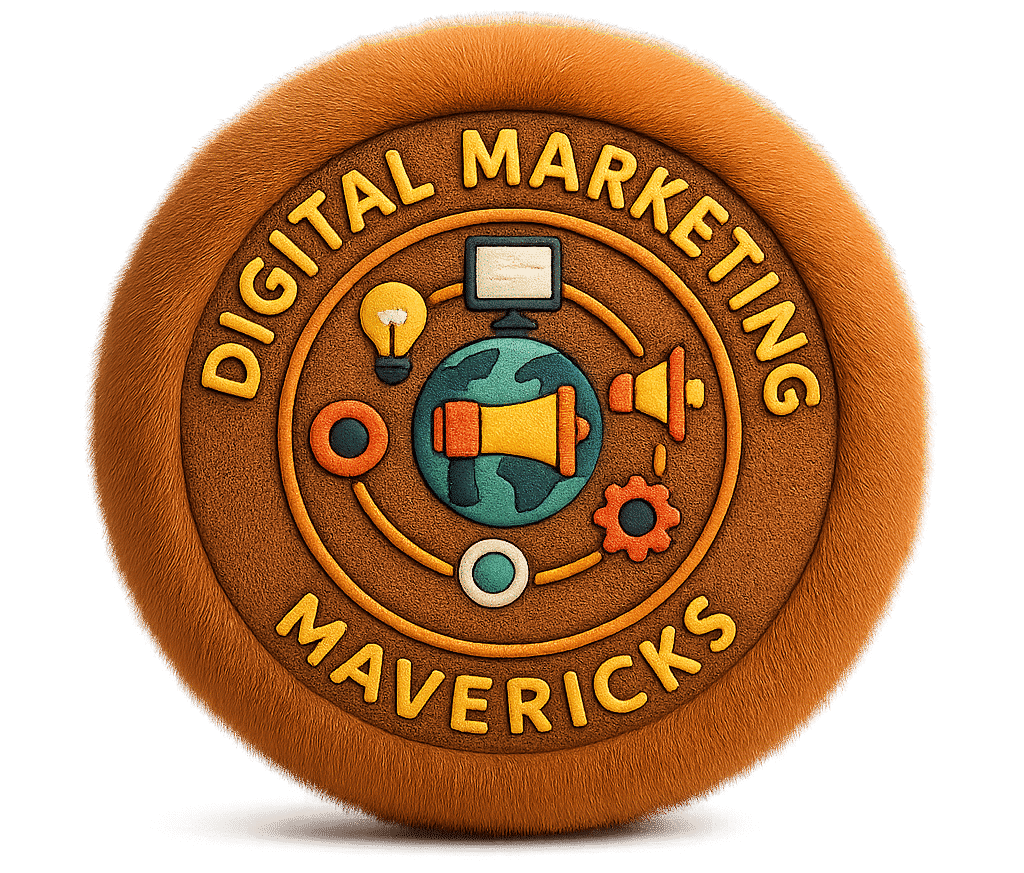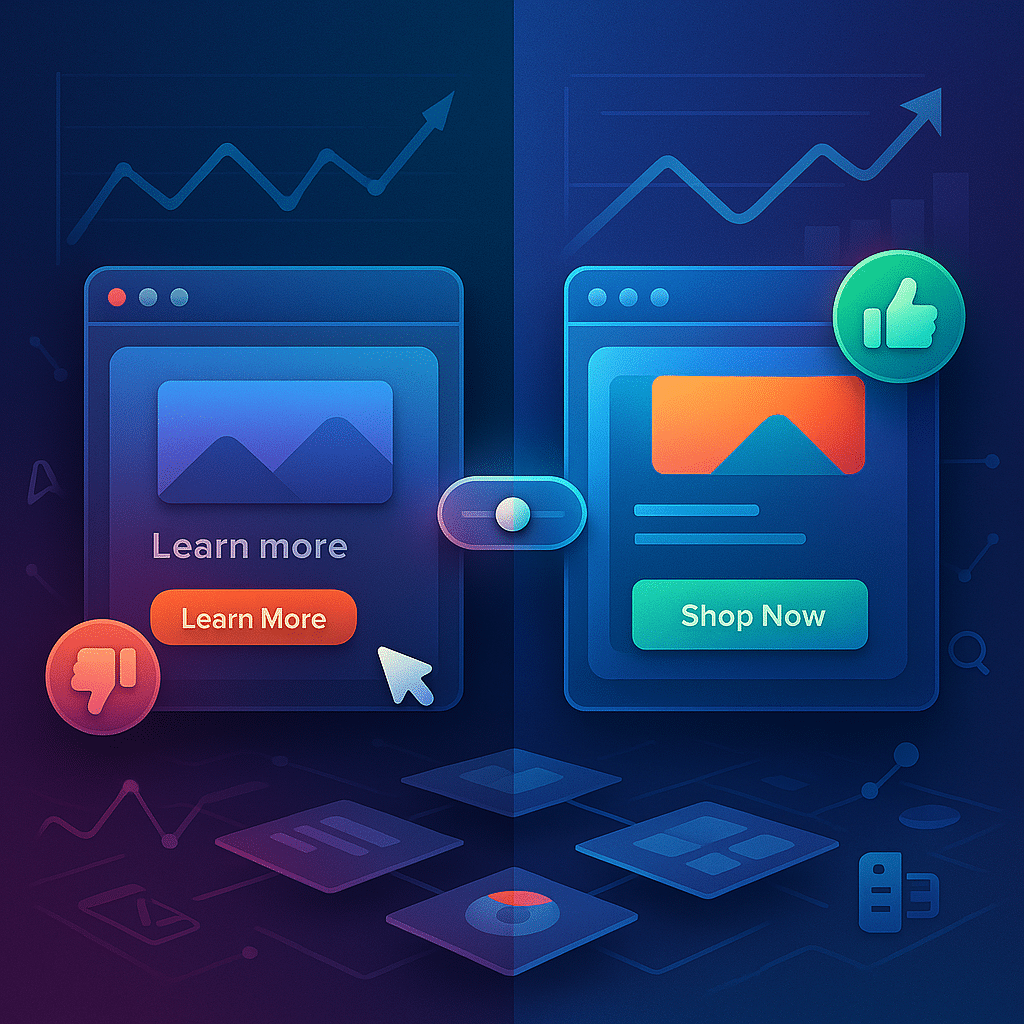You can have the best product, the perfect audience, and a solid budget, but if your ad copy misses the mark?
You’re paying for scrolls, not clicks. And definitely not conversions.
Ad copy optimization isn’t just about writing better ads it’s about consistently improving the words, visuals, and messages that drive action on platforms like Google Ads and Meta Ads (Facebook & Instagram).
Because here’s the truth:
People don’t click on average. They click on relevant, emotional, benefit-packed messaging that speaks directly to what they want or need.
The right copy can:
- Lower your cost per click (CPC)
- Boost click-through rates (CTR)
- Increase conversions
- Improve Quality Score or Relevance Score
- Keep your ads profitable longer
Whether you’re writing responsive search ads for Google or thumb-stopping Meta creatives for mobile, the goal is the same:
Get attention. Keep it. Convert it.
In this guide, we’ll break down exactly how to optimize your ad copy (and creative) across the funnel with actionable tips, examples, and frameworks that actually work in 2025.
Let’s make every word (and every dollar) count.
What Is Ad Copy Optimization?
Ad copy optimization isn’t just about writing prettier headlines or clever taglines.
It’s about writing ads that perform, then improving them based on real data from real campaigns.
A Simple Definition:
Ad copy optimization is the ongoing process of improving your ad messaging — including headlines, descriptions, CTAs, and visuals — to increase click-through rates, lower costs, and drive more conversions.
It’s not a one-time edit. It’s a cycle:
Write → Launch → Measure → Improve → Repeat
Writing vs. Optimizing
Writing ad copy = starting from scratch.
Optimizing ad copy = taking what’s already live and making it better.
That means:
- Testing new angles
- Rewriting weak headlines
- Swapping CTAs
- Pairing stronger copy with better creative
- Adapting based on funnel stage, audience segment, or platform behavior
Optimization starts when the ads are already running because that’s when you get the data that tells you what’s working and what’s not.
Why It’s Critical
Poorly optimized copy can lead to:
- Low click-through rates
- Higher cost per click (CPC)
- Fewer conversions
- Lower Quality Scores (Google) or low Relevance Scores (Meta)
- Faster creative fatigue and wasted ad spend
Meanwhile, well-optimized copy keeps your ads:
- Fresh
- Relevant
- Profitable
And when your messaging hits just right?
📉 Costs go down
📈 Conversions go up
🚀 Campaigns scale more easily
How Ad Platforms Evaluate and Rank Your Ad Copy
You don’t just write ad copy for humans you write it for algorithms, too.
Both Google Ads and Meta Ads analyze your copy (and creative) behind the scenes to decide:
- Who sees your ads
- How much you pay per click
- Whether your ads even get shown at all
Let’s break it down by platform.
Google Ads: Quality Score Matters
Google rewards ad copy that aligns with user intent. Your ad must match:
- The keywords being searched
- The expectation of the searcher
- The landing page experience that follows
Your Quality Score (on a scale of 1–10) is based on:
- Ad Relevance – how closely your copy matches the search query
- Expected CTR – how likely users are to click
- Landing Page Experience – does the page deliver on your ad’s promise?
📉 A low score = higher CPCs and poor ad rank
📈 A high score = lower costs and better placement
Tip: Use your target keywords in headlines and descriptions naturally, and keep your CTA closely aligned with the page content.
Meta Ads: Engagement Is King
Meta (Facebook & Instagram) doesn’t use a Quality Score per se but it does use a Relevance Ranking system that affects delivery and cost.
Your ad performance is influenced by:
- CTR (click-through rate)
- Engagement rate (likes, shares, comments)
- Post-click behavior (e.g. time on site, conversions)
- Negative feedback (hiding or reporting your ad)
The more engaging and relevant your ad copy and creative are to the audience, the better Meta’s algorithm will treat you often lowering your cost per result.
Tip: Use copy that’s personal, conversational, and benefit-driven — and match it with eye-catching visuals that stop the scroll.
Ad Copy Writing
Great ad copy doesn’t happen by accident.
Whether you’re writing for Google Ads or Meta Ads, every word (and format) has a job to do; grab attention, drive action, and support the offer.
Here’s how to write ad copy that performs.
Google Ad Copy (Search-Focused, Intent-Driven)
Google ads are text-based and structured but that doesn’t mean they can’t be persuasive. You just need to pack power into limited space.
Key Elements to Optimize:
- Headline 1: Include your main keyword to boost relevance and help your Quality Score.
Example: “Affordable Wedding Photographer NYC” - Headline 2: Add a unique benefit, credibility, or differentiator.
Example: “Trusted by 200+ Couples” or “Book in 60 Seconds” - Headline 3 (optional): Use a CTA or value-add.
Example: “Free Consultation Today” or “See Our Portfolio” - Descriptions: Expand on your offer with clarity, urgency, or proof.
Example: “Award-winning service with transparent pricing. Reserve your date today.” - Display Path: Customize to support the message or CTA.
Example:/wedding-photography/pricing - Extensions: Add sitelinks, callouts, reviews, phone numbers, these increase CTR and real estate in search results.
Tip: Make your ad match the intent of the keyword. Someone searching “emergency plumber” wants fast service, not a company history.
Meta Ad Copy (Visual-First, Emotion-Driven)
On Meta platforms (Facebook/Instagram), you’re working with scroll-stopping visuals supported by compelling copy.
Key Copy Components:
- Primary Text (above the image/video)
- Start with a hook: bold statement, question, or emotional trigger
- Lead with benefits, not features
- Use line breaks for scannability
- Keep mobile in mind: short and sweet beats long and clever
- Headline (below the creative)
- Reinforce the offer or CTA
- Keep it clear and results-focused
- Example: “Book Your Free Trial Today” or “Get 25% Off Before Friday”
- Description (optional)
- Add context, urgency, or details only visible in some placements
- CTA Button
- Choose based on the funnel stage (e.g., “Learn More” for top, “Shop Now” or “Book Now” for bottom)
Tip: Your copy should sound like a real person talking — not a press release. Personal, punchy, and purposeful wins the scroll war.
Universal Copywriting Tips (for All Platforms)
- Lead with value – What’s in it for the user?
- Use strong verbs – Show action, not fluff
- Focus on clarity over cleverness – Confused users don’t click
- Add numbers, timeframes, or proof – Builds trust fast
- End with a strong CTA – Tell them exactly what to do next
Crafting Copy for Every Stage of the Funnel
Not all clicks are created equal and not all ad copy should sound the same.
Your audience goes through stages:
- Awareness — “I have a problem.”
- Consideration — “I’m exploring solutions.”
- Conversion — “I’m ready to act.”
- Retargeting — “I need a reminder or reason to finish.”
Your copy should speak to where they are, not just what you sell.
Top of Funnel (Awareness)
Your audience isn’t looking for you yet, they’re just becoming aware of a problem or opportunity.
Goal: Grab attention and build curiosity.
Google Ads Copy Example:
Headline: “Trouble Keeping Track of Your Expenses?”
Description: “Discover the easiest way to manage small business finances. No spreadsheets required.”
Meta Ads Copy Example:
Primary Text: “Feeling overwhelmed by your business books?”
Headline: “Try This Free Accounting App for 14 Days”
CTA: Learn More
Use emotional hooks, pain points, and big-picture benefits.
Middle of Funnel (Consideration)
Now they’re comparing solutions. You’re on their radar, but not the only option.
Goal: Show value, build trust, offer proof.
Google Ads Copy Example:
Headline: “Compare the Top 5 Accounting Tools”
Description: “See why 1,000+ business owners choose [Brand]. Transparent pricing & 5-star support.”
Meta Ads Copy Example:
Primary Text: “Switching accounting tools? Here’s why thousands of businesses choose us over QuickBooks.”
Headline: “See How We Compare”
CTA: Learn More
Use testimonials, features, comparisons, or credibility signals.
Bottom of Funnel (Conversion)
They’re ready to act, but they need a push.
Goal: Eliminate friction. Add urgency. Make the next step easy.
Google Ads Copy Example:
Headline: “Start Your Free Trial Today”
Description: “No credit card. Full access. Cancel anytime. Get started in 60 seconds.”
Meta Ads Copy Example:
Primary Text: “Try us free for 14 days — and keep your sanity during tax season.”
Headline: “Start Now — No Credit Card Required”
CTA: Start Free Trial
This is where direct CTAs, offers, and guarantees shine.
Retargeting (Stay Top-of-Mind)
These users already interacted. They visited your site, watched your video, or clicked your ad.
Goal: Re-engage and remove doubt.
Google Ads Copy Example (RLSA):
Headline: “Still Comparing Tools?”
Description: “Try [Brand] free. No contracts. Just results.”
Meta Ads Copy Example:
Primary Text: “Still thinking it over? Your free trial is still waiting.”
Headline: “Come Back and Finish Signing Up”
CTA: Sign Up
Use reminders, incentives, and objection-handling.
Visuals & Creatives: The Other Half of Optimization
You can write the best copy in the world but if the creative doesn’t stop the scroll or support the message?
You’re still getting skipped.
Especially on platforms like Meta, where ads blend into content feeds, your visuals are your first impression.
Even on Google, with responsive display or YouTube ads, creative can make or break the outcome.
Let’s make it count.
On Meta (Facebook & Instagram): Visuals Are the Ad
Your visual often decides if someone even reads your copy. It needs to:
- Stop the scroll
- Match the message
- Feel native to the platform
Top Performing Creative Types:
- Short-form video (Reels, Stories, feed — under 30 seconds)
- Carousel ads (great for storytelling or product features)
- UGC (User-Generated Content) — feels authentic, builds trust
- Lifestyle imagery — product in context > product on a white background
- Branded motion graphics — good for awareness and offers
Make sure your creative passes the 3-second test: Is it clear, interesting, and relevant immediately?
While Google is text-driven for Search, other formats rely heavily on visuals:
- Responsive Display Ads – Combine headlines, images, and logos dynamically
- YouTube Ads – Hook in the first 5 seconds or they’ll skip
- Discovery Ads – Show up on Gmail, YouTube Home, and Discover feed (mobile-heavy)
Visual Optimization Tips:
- Use high-contrast images or branded colors to stand out
- Include people or product-in-use for relatability
- Make your value prop visible in the creative (especially on YouTube)
- Avoid overly corporate stock imagery. They feel cold and generic
Best Practices Across All Creatives:
- Keep it clean – Avoid cluttered visuals or too much text
- Brand it subtly – Add logo, colors, or packaging to reinforce identity
- Align copy and creative – They should reinforce each other, not compete
- Test formats – What works as a video may fail as a static image (and vice versa)
- Refresh regularly – Most creatives fatigue after 10–14 days depending on spend
Example: Meta Ad Breakdown
Offer: 14-day free trial for bookkeeping app
Primary Text: “Overwhelmed by spreadsheets? Try bookkeeping made simple.”
Creative:
- UGC-style video of a small business owner using the app
- Captions showing “before vs after” stress levels
- Clear visual cue: 14-day trial badge
CTA: “Start Free Trial”
Why it works:
Real person, relatable struggle, clear offer, visual support = performance.
A/B Testing Ad Copy the Right Way
A/B testing is the backbone of ad copy optimization. It’s how you figure out what resonates, what falls flat, and what to scale.
But here’s the problem:
Most people test too many things at once, kill tests too early, or never look beyond surface metrics.
Let’s fix that.
The Golden Rule: Test One Variable at a Time
Want to know what’s working? Change just one thing per variation. Otherwise, you won’t know what made the difference.
Examples:
- Headline A vs Headline B
- Image A vs Image B (same text)
- CTA “Book Now” vs “Get Started”
- Emotional hook vs logical value prop
What to Test in Your Ad Copy (High Impact Areas)
| Platform | What to Test |
|---|---|
| Google Ads | Headlines, descriptions, CTAs, display paths |
| Meta Ads | Primary text, creative, CTA button, hook, angle |
How Long to Run a Test
- Minimum 3–5 days for Meta (depending on spend + impressions)
- At least 1,000 impressions or 100 clicks before judging CTR
- Wait for 50+ conversions before judging CPA or ROAS
Don’t pause early just because one variation starts strong. Performance stabilizes over time.
Where to Analyze Results
- Google Ads: Ad group > Ads & Extensions → sort by CTR, conversions, CPA
- Meta Ads Manager: Ad > Breakdown > by creative or placement → track results by variation
Focus on:
- CTR for engagement
- CPC/CPA for cost control
- Conversion rate for landing page alignment
- ROAS for revenue efficiency
Testing Tips:
- Use naming conventions to stay organized (e.g. “V1_EmotionalHeadline”)
- Test against a solid “control” ad, not just random new versions
- Archive winners and reuse top performers as starting points for new campaigns
What NOT to Do:
- Test 3+ variables at once
- Change your audience during a copy test
- Judge a test too early based on small sample sizes
- Assume one win = forever success (fatigue is real)
Tools to Help Write & Optimize Ad Copy
You don’t have to write every headline or analyze every ad manually.
The best advertisers use tools to:
- Speed up brainstorming
- Improve clarity and structure
- Track results and performance
- Stay organized while testing
Here’s what to keep in your toolbox
Writing & Brainstorming Tools
- ChatGPT / AI Copy Assistants
Generate hooks, angles, and ad copy variants based on prompts.
Great for fast ideation or writing multiple variations per audience or funnel stage. - Copy.ai / Jasper
Paid tools built for marketers with templates for headlines, CTAs, and ad copy.
Especially useful for Facebook Ads. - AnswerThePublic / AlsoAsked
Discover real-world pain points and questions to base your ad angles on.
Helps with top-of-funnel messaging. - CoSchedule Headline Analyzer
Score your headlines for emotional impact, clarity, and engagement.
Use for ad headlines and primary text intros.
Optimization & Testing Tools
- Google Ads Experiments
Run formal A/B tests directly in your campaigns.
Great for testing bidding strategies or ad copy at scale. - Meta Ads Creative Hub
Build and preview your Meta ad mockups, test layout, format, and mobile view.
Collaborate on creatives before publishing. - Facebook Ad Library
See what your competitors (or top brands) are running right now.
Steal angles, formats, or CTA styles. - AdEspresso (by Hootsuite)
Split test Meta Ads more easily with pre-built dashboards.
Simplifies tracking ad variants, especially for teams. - Google Keyword Planner
Identify keywords and intent signals to weave into Google ad copy.
Especially helpful for search-based campaigns.
Organization & Planning Tools
- Airtable or Google Sheets
Plan, label, and archive ad copy variants, testing notes, and performance
Use naming conventions and funnel tags to stay organized - Notion or Trello
Set up a swipe file, task flow, or creative testing calendar
Helps you track what’s live, what’s next, and what worked
Common Ad Copy Mistakes That Hurt Performance
Even with a solid strategy, it’s easy to slip into habits that tank your click-through rate, burn your budget, or confuse your audience.
Here are the biggest copy pitfalls to watch for and how to avoid them.
1. Being Vague or Generic
Ads like “We’re the best in town!” or “Solutions you can trust” don’t say anything useful.
Be specific. Highlight a benefit, use a number, or call out a pain point:
“24/7 AC Repair in Miami — No Hidden Fees”
2. Writing the Same Copy for Every Audience
Talking to a cold audience? You need a hook.
Retargeting someone who already visited your site? They need a nudge.
Match copy to intent and funnel stage. One-size-fits-all = lower conversions.
3. Leading With Features, Not Benefits
No one cares that your software has “6 layers of encryption.”
They care that it protects their business data without stress.
Show how the feature improves their life, saves time, or solves a problem.
4. Weak or Missing CTA
If your ad doesn’t tell people what to do next, they won’t do anything.
Use strong, clear CTAs:
- “Book Your Free Call”
- “Download Now”
- “Get 30% Off Today”
Pro tip: match your CTA to the platform and funnel stage.
5. Ignoring Ad Copy Fatigue
Even great copy wears out. Performance drops after a few weeks especially on Meta.
Refresh hooks, rotate offers, and test new angles every 2–4 weeks depending on budget.
6. Misleading or Overpromising
Don’t bait users with one message and deliver something else on the landing page.
Make sure your headline, body, and page all align.
Google especially penalizes this with a lower Quality Score.
7. Not Testing Enough Variants
One ad version won’t cut it. You need to test angles, formats, CTAs, and tone.
Always be running 2–3 ad variations minimum per ad group or ad set.
How to Create a Scalable Ad Copy System
Writing one great ad is fine.
But writing dozens of great ads, across multiple platforms, audiences, and funnel stages?
That’s where most businesses break down.
To scale paid ads efficiently, you need more than creativity, you need a system.
1. Build a Copy Template Library
Create modular templates for:
- Google search ad headlines
- Meta ad primary texts
- CTAs by funnel stage
- Offers and promo language
- Emotional vs logical hooks
Use frameworks like:
- Problem → Agitate → Solve
- Hook → Benefit → CTA
- Before → After → Bridge
2. Organize by Funnel Stage & Persona
Map your copy assets to:
- Awareness, consideration, conversion, and retargeting
- Customer avatars (e.g., first-time buyer, repeat customer, DIY vs done-for-you)
Tag each ad variation in Google Sheets, Airtable, or Notion so you can plug and play as needed.
3. Set a Creative Refresh Calendar
Avoid fatigue by rotating ad copy every:
- 2–4 weeks for Meta (depending on budget)
- 4–6 weeks for Google Search (slower fatigue, but still real)
Batch-write your variations ahead of time so you’re never scrambling when CTR drops.
4. Repurpose High-Performing Copy Across Platforms
If a headline kills it on Meta, adapt it for:
- Google responsive ads
- Email subject lines
- Landing page headers
- Retargeting copy
Use top-performing angles as starting points for new ad tests.
5. Create a Swipe File
Save:
- Your own best-performing ads
- Competitor ads from Meta Ad Library or Google search
- Great copy you see anywhere (LinkedIn, emails, YouTube pre-roll)
Review it weekly for inspiration and creative angles.
Final Word
Winning ad campaigns don’t start perfect.
They get that way through iteration, testing, and data-driven refinement.
Ad copy optimization isn’t about clever words, it’s about clarity, alignment, and performance.
It’s the difference between an ad that scrolls by and one that sells.
So here’s your roadmap:
- Write for the platform, funnel, and audience
- Back every word with purpose
- Test relentlessly
- Keep what works, toss what doesn’t
- And scale using a system not guesswork
Because when you optimize your message, you maximize every click, every dollar, and every opportunity.
Check out our article on crafting a winning ad strategy for your specific goals!
FAQs
What is ad copy ?
Ad copy is the written content in an ad like headlines, descriptions, and calls to action — designed to grab attention and drive clicks or conversions.
How often should I update my ad copy?
Every 2–4 weeks for Meta; every 4–6 weeks for Google, depending on budget and performance.
What makes good ad copy?
Clarity, relevance, benefit-driven language, and a strong CTA. It should match the audience’s stage in the funnel.
Should I test different copy versions?
Absolutely. Always A/B test one variable at a time to see what actually improves results.
Does creative matter more than copy?
Both matter but on Meta especially, creative stops the scroll, and copy closes the deal. They should work together.
